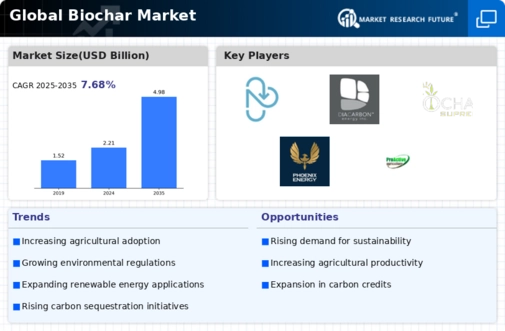Market Growth Projections
The Global Global Biochar Market Industry is projected to experience substantial growth in the coming years. With a market value of 2.21 USD Billion in 2024, the industry is expected to expand significantly, reaching 4.98 USD Billion by 2035. This growth trajectory indicates a robust compound annual growth rate (CAGR) of 7.67% from 2025 to 2035. Factors contributing to this growth include increasing environmental awareness, government support, and rising agricultural demand for sustainable practices. The market's expansion reflects a broader trend towards sustainability and resource efficiency, positioning biochar as a key player in the global effort to combat climate change.
Rising Agricultural Demand
The Global Global Biochar Market Industry is significantly influenced by the rising demand for sustainable agricultural practices. As global food production faces challenges from soil degradation and climate change, biochar emerges as a viable solution to enhance soil health and crop yields. Farmers are increasingly recognizing the benefits of biochar, which include improved water retention and nutrient availability. This trend is evident in regions where biochar application has led to substantial increases in crop productivity. The market is anticipated to grow at a CAGR of 7.67% from 2025 to 2035, reflecting the agricultural sector's shift towards sustainable practices that biochar facilitates.
Growing Interest in Carbon Credits
The Global Global Biochar Market Industry is witnessing a growing interest in carbon credits as businesses and governments seek to offset their carbon footprints. Biochar's ability to sequester carbon for extended periods positions it as a valuable asset in carbon trading schemes. Companies are increasingly investing in biochar projects to generate carbon credits, which can be sold to meet regulatory requirements or voluntary sustainability goals. This trend not only incentivizes biochar production but also enhances its market value. As awareness of carbon trading expands, the biochar market is poised for growth, driven by its potential to contribute to global carbon reduction efforts.
Increasing Environmental Awareness
The Global Global Biochar Market Industry experiences a notable surge in demand due to heightened environmental awareness among consumers and businesses. As climate change concerns escalate, stakeholders are increasingly seeking sustainable solutions to mitigate carbon emissions. Biochar, recognized for its ability to sequester carbon and improve soil health, aligns with these sustainability goals. For instance, various agricultural sectors are adopting biochar to enhance soil fertility while reducing reliance on chemical fertilizers. This trend is expected to contribute to the market's growth, with projections indicating a market value of 2.21 USD Billion in 2024, reflecting a growing commitment to eco-friendly practices.
Government Initiatives and Regulations
Government initiatives play a pivotal role in shaping the Global Global Biochar Market Industry. Numerous countries are implementing policies and regulations that promote the use of biochar as a means to achieve carbon neutrality and enhance soil quality. For example, several nations have introduced subsidies for biochar production and usage, encouraging farmers to adopt this sustainable practice. Such governmental support not only boosts market growth but also fosters innovation in biochar production technologies. As a result, the market is projected to reach 4.98 USD Billion by 2035, driven by these regulatory frameworks that incentivize environmentally responsible practices.
Technological Advancements in Production
Technological advancements in biochar production are transforming the Global Global Biochar Market Industry. Innovations in pyrolysis and gasification technologies are enhancing the efficiency and scalability of biochar production processes. These advancements not only reduce production costs but also improve the quality of biochar, making it more appealing to various industries, including agriculture and waste management. As production methods become more efficient, the market is likely to attract increased investment, further driving growth. The ongoing development of these technologies suggests a promising future for the market, aligning with the increasing global focus on sustainable resource management.
















Leave a Comment